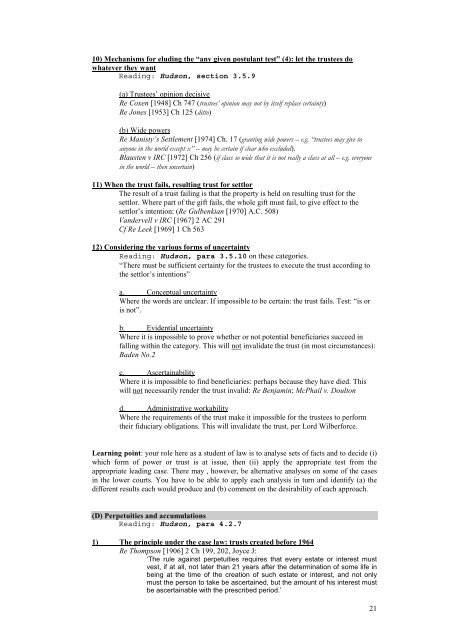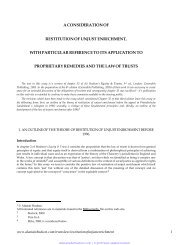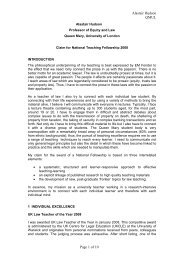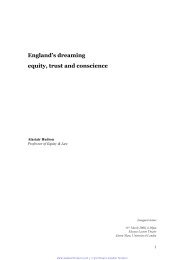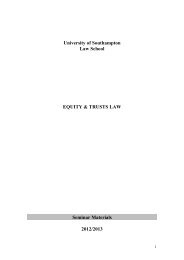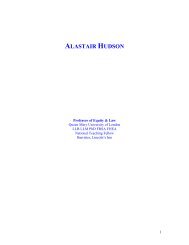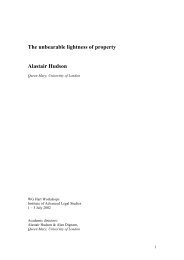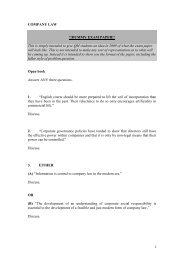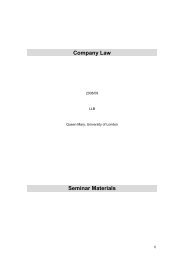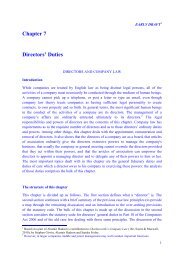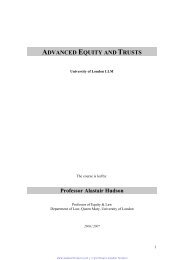Soton Equity and Trusts - alastairhudson.com
Soton Equity and Trusts - alastairhudson.com
Soton Equity and Trusts - alastairhudson.com
Create successful ePaper yourself
Turn your PDF publications into a flip-book with our unique Google optimized e-Paper software.
10) Mechanisms for eluding the “any given postulant test” (4): let the trustees do<br />
whatever they want<br />
Reading: Hudson, section 3.5.9<br />
(a) Trustees’ opinion decisive<br />
Re Coxen [1948] Ch 747 (trustees’ opinion may not by itself replace certainty)<br />
Re Jones [1953] Ch 125 (ditto)<br />
(b) Wide powers<br />
Re Manisty’s Settlement [1974] Ch. 17 (granting wide powers – e.g. “trustees may give to<br />
anyone in the world except x” – may be certain if clear who excluded).<br />
Blausten v IRC [1972] Ch 256 (if class so wide that it is not really a class at all – e.g. everyone<br />
in the world – then uncertain)<br />
11) When the trust fails, resulting trust for settlor<br />
The result of a trust failing is that the property is held on resulting trust for the<br />
settlor. Where part of the gift fails, the whole gift must fail, to give effect to the<br />
settlor’s intention: (Re Gulbenkian [1970] A.C. 508)<br />
V<strong>and</strong>ervell v IRC [1967] 2 AC 291<br />
Cf Re Leek [1969] 1 Ch 563<br />
12) Considering the various forms of uncertainty<br />
Reading: Hudson, para 3.5.10 on these categories.<br />
“There must be sufficient certainty for the trustees to execute the trust according to<br />
the settlor’s intentions”<br />
a. Conceptual uncertainty<br />
Where the words are unclear. If impossible to be certain: the trust fails. Test: “is or<br />
is not”.<br />
b. Evidential uncertainty<br />
Where it is impossible to prove whether or not potential beneficiaries succeed in<br />
falling within the category. This will not invalidate the trust (in most circumstances):<br />
Baden No.2<br />
c. Ascertainability<br />
Where it is impossible to find beneficiaries: perhaps because they have died. This<br />
will not necessarily render the trust invalid: Re Benjamin; McPhail v. Doulton<br />
d. Administrative workability<br />
Where the requirements of the trust make it impossible for the trustees to perform<br />
their fiduciary obligations. This will invalidate the trust, per Lord Wilberforce.<br />
Learning point: your role here as a student of law is to analyse sets of facts <strong>and</strong> to decide (i)<br />
which form of power or trust is at issue, then (ii) apply the appropriate test from the<br />
appropriate leading case. There may , however, be alternative analyses on some of the cases<br />
in the lower courts. You have to be able to apply each analysis in turn <strong>and</strong> identify (a) the<br />
different results each would produce <strong>and</strong> (b) <strong>com</strong>ment on the desirability of each approach.<br />
(D) Perpetuities <strong>and</strong> accumulations<br />
Reading: Hudson, para 4.2.7<br />
1) The principle under the case law: trusts created before 1964<br />
Re Thompson [1906] 2 Ch 199, 202, Joyce J:<br />
‘The rule against perpetuities requires that every estate or interest must<br />
vest, if at all, not later than 21 years after the determination of some life in<br />
being at the time of the creation of such estate or interest, <strong>and</strong> not only<br />
must the person to take be ascertained, but the amount of his interest must<br />
be ascertainable with the prescribed period.’<br />
21


